-
 Bitcoin
Bitcoin $116400
-0.36% -
 Ethereum
Ethereum $4033
3.40% -
 XRP
XRP $3.302
-1.26% -
 Tether USDt
Tether USDt $1.000
-0.02% -
 BNB
BNB $796.1
1.67% -
 Solana
Solana $177.8
1.89% -
 USDC
USDC $0.9999
0.00% -
 Dogecoin
Dogecoin $0.2314
4.09% -
 TRON
TRON $0.3381
0.14% -
 Cardano
Cardano $0.7989
1.22% -
 Stellar
Stellar $0.4496
-1.84% -
 Chainlink
Chainlink $20.42
9.42% -
 Hyperliquid
Hyperliquid $41.17
0.88% -
 Sui
Sui $3.914
3.77% -
 Bitcoin Cash
Bitcoin Cash $584.7
1.52% -
 Hedera
Hedera $0.2632
-0.54% -
 Avalanche
Avalanche $24.09
3.40% -
 Ethena USDe
Ethena USDe $1.001
-0.02% -
 Litecoin
Litecoin $123.2
1.33% -
 Toncoin
Toncoin $3.318
-0.04% -
 UNUS SED LEO
UNUS SED LEO $8.984
-0.05% -
 Shiba Inu
Shiba Inu $0.00001323
2.85% -
 Uniswap
Uniswap $10.90
4.41% -
 Polkadot
Polkadot $3.999
3.34% -
 Dai
Dai $1.000
0.01% -
 Cronos
Cronos $0.1630
9.64% -
 Bitget Token
Bitget Token $4.484
0.82% -
 Monero
Monero $272.4
2.44% -
 Pepe
Pepe $0.00001173
6.03% -
 Aave
Aave $290.8
2.88%
How to operate the SAR indicator from green to red? How to confirm the reversal signal?
The SAR indicator, appearing as dots on charts, signals bullish trends when below price and bearish when above, with a color shift from green to red indicating a trend reversal.
Jun 02, 2025 at 11:42 pm
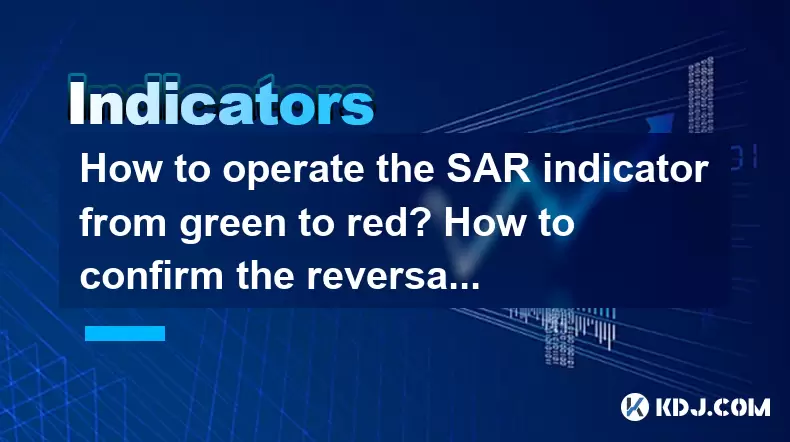
Understanding the SAR Indicator
The SAR (Stop and Reverse) indicator is a popular tool used by traders in the cryptocurrency market to determine potential entry and exit points. The indicator appears as a series of dots placed either above or below the price action on a chart. When the dots are below the price, it suggests that the trend is bullish, and when the dots are above the price, it indicates a bearish trend. The transition from green to red on the SAR indicator signifies a change in the trend from bullish to bearish, which is crucial for traders to recognize and act upon.
Operating the SAR Indicator from Green to Red
To effectively operate the SAR indicator from green to red, traders need to follow a systematic approach. Here are the steps to monitor the transition:
- Monitor the Dots: Keep an eye on the SAR dots on your chart. Initially, they will be positioned below the price candles, indicating a bullish trend, and colored green.
- Observe the Shift: As the market dynamics change, watch for the dots to start moving closer to the price candles. This indicates that the bullish momentum is weakening.
- Confirm the Reversal: The moment the dots move above the price candles, the color changes from green to red, signaling a bearish trend. This is the key moment to take action based on your trading strategy.
Confirming the Reversal Signal
Confirming a reversal signal from the SAR indicator involves more than just observing the change in dot position and color. Here are additional steps to ensure the validity of the signal:
- Price Action Confirmation: Look for a clear bearish candlestick pattern or a significant price drop following the SAR dots turning red. This can include patterns like bearish engulfing, shooting stars, or three black crows.
- Volume Analysis: Increased trading volume during the transition can validate the bearish trend. High volume indicates strong market participation in the bearish move.
- Other Indicators: Use additional technical indicators like the Relative Strength Index (RSI) or Moving Average Convergence Divergence (MACD) to confirm the bearish signal. For instance, if the RSI moves below 70 from an overbought condition, it can reinforce the bearish signal from the SAR.
Setting Up the SAR Indicator on Your Trading Platform
To set up the SAR indicator on your trading platform, follow these steps:
- Open Your Trading Platform: Navigate to your preferred cryptocurrency trading platform.
- Access the Indicators: Locate the indicators menu, usually found under the chart settings or tools section.
- Select SAR Indicator: From the list of available indicators, select the SAR indicator.
- Adjust Settings: Most platforms allow you to adjust the acceleration factor and maximum value. The default settings are typically an acceleration factor of 0.02 and a maximum value of 0.2, but you can modify these based on your trading strategy.
- Apply the Indicator: Once the settings are adjusted, apply the indicator to your chart. The SAR dots will appear, and you can start monitoring them for trend changes.
Practical Example of Using SAR Indicator
To illustrate how to use the SAR indicator from green to red, consider the following example:
- Bullish Trend: You observe that Bitcoin is in a bullish trend, with the SAR dots positioned below the price candles and colored green.
- Weakening Momentum: Over time, you notice the dots starting to move closer to the price candles, indicating a potential weakening of the bullish trend.
- Reversal Signal: Suddenly, the dots cross above the price candles and turn red. This is a clear signal that the trend has shifted to bearish.
- Confirmation: You look for a bearish candlestick pattern, such as a bearish engulfing, and notice a significant increase in trading volume. Additionally, the RSI moves below 70, confirming the bearish signal from the SAR.
- Action: Based on this confirmation, you decide to enter a short position or exit any long positions, aligning your trades with the new bearish trend.
Common Mistakes to Avoid
When using the SAR indicator, it's important to be aware of common pitfalls that can lead to misinterpretation of signals:
- Overreliance on SAR Alone: Relying solely on the SAR indicator without confirming signals from other tools can lead to false signals. Always use additional indicators and price action analysis to validate the SAR signals.
- Ignoring Market Context: The effectiveness of the SAR indicator can vary depending on market volatility and overall trend strength. Always consider the broader market context before acting on SAR signals.
- Improper Settings: Using default settings without adjusting them to suit your trading strategy can result in suboptimal performance. Experiment with different settings to find what works best for your trading style.
FAQs
Q: Can the SAR indicator be used for all timeframes?
A: Yes, the SAR indicator can be used across various timeframes, from short-term intraday charts to long-term weekly or monthly charts. However, its effectiveness may vary depending on the timeframe and market volatility. Shorter timeframes might produce more frequent signals, which could be useful for day traders, while longer timeframes might be more suitable for swing or position traders.
Q: How does the acceleration factor affect the SAR indicator?
A: The acceleration factor determines how quickly the SAR dots move towards the price. A higher acceleration factor will cause the dots to move faster, potentially resulting in more frequent signals. Conversely, a lower acceleration factor will result in slower movement of the dots, which can be useful for capturing longer-term trends.
Q: Is it possible to use the SAR indicator in combination with other trading strategies?
A: Absolutely, the SAR indicator can be effectively combined with other trading strategies and indicators. For example, you might use it alongside trend lines, support and resistance levels, or other momentum indicators like the MACD or RSI to create a more robust trading system. This combination can help filter out false signals and improve the accuracy of your trades.
Q: What are some alternative indicators to the SAR for trend reversal?
A: Some alternative indicators for identifying trend reversals include the Parabolic SAR, which is similar to the SAR but uses a different calculation method, the ADX (Average Directional Index), which measures trend strength, and the Ichimoku Cloud, which provides a comprehensive view of support, resistance, and trend direction. Each of these indicators has its unique features and can be used to complement or replace the SAR depending on your trading preferences.
Disclaimer:info@kdj.com
The information provided is not trading advice. kdj.com does not assume any responsibility for any investments made based on the information provided in this article. Cryptocurrencies are highly volatile and it is highly recommended that you invest with caution after thorough research!
If you believe that the content used on this website infringes your copyright, please contact us immediately (info@kdj.com) and we will delete it promptly.
- Shiba Inu (SHIB) in the Crypto Landscape: Community, Trends, and Future Outlook
- 2025-08-09 20:30:12
- Lasers in Modern Warfare: Iron Beam and the Future of Defense
- 2025-08-09 20:30:12
- Maxi Doge Presale: The Meme Coin That's Pumping Iron and Prices!
- 2025-08-09 19:10:11
- Rare Coin Warning: Don't Get Fooled by That 1p Coin!
- 2025-08-09 18:50:12
- Cardano, Unilabs, and Tron Price: Decoding the Latest Crypto Buzz
- 2025-08-09 18:30:12
- Aerodrome Finance: Price Targets and the Bullish Channel - What's Next?
- 2025-08-09 18:50:12
Related knowledge

What does it mean when the Triple Moving Average (TRIX) turns downward but the price doesn't fall?
Aug 09,2025 at 12:42pm
Understanding the Triple Moving Average (TRIX) IndicatorThe Triple Moving Average, commonly known as TRIX, is a momentum oscillator designed to filter...

What does it mean when the Williams' oscillator repeatedly hits bottoms but fails to rebound?
Aug 09,2025 at 09:28am
Understanding the Williams %R OscillatorThe Williams %R oscillator, developed by Larry Williams, is a momentum indicator used in technical analysis to...
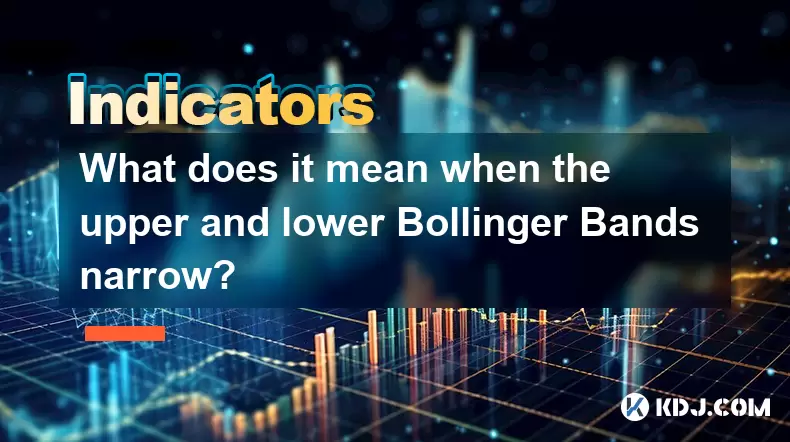
What does it mean when the upper and lower Bollinger Bands narrow?
Aug 09,2025 at 03:00pm
Understanding Bollinger Bands in Cryptocurrency TradingBollinger Bands are a widely used technical analysis tool in the cryptocurrency market, develop...
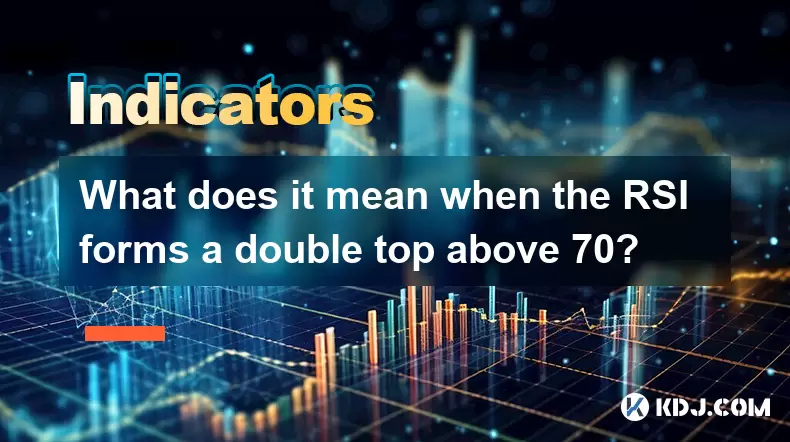
What does it mean when the RSI forms a double top above 70?
Aug 09,2025 at 05:50pm
Understanding the RSI and Overbought ConditionsThe Relative Strength Index (RSI) is a momentum oscillator that measures the speed and change of price ...
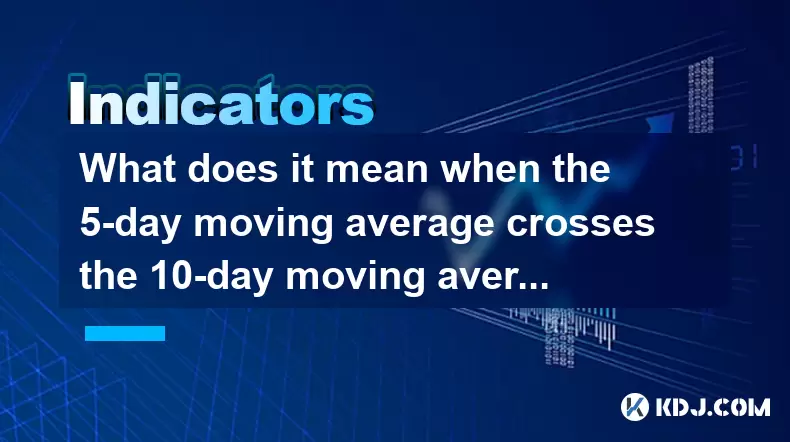
What does it mean when the 5-day moving average crosses the 10-day moving average but the 20-day moving average remains upward?
Aug 09,2025 at 03:35pm
Understanding Moving Averages in Cryptocurrency TradingMoving averages are foundational tools in technical analysis, especially within the cryptocurre...
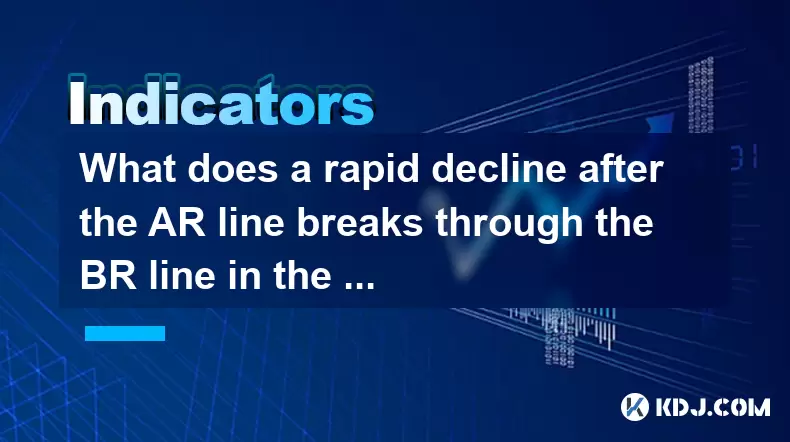
What does a rapid decline after the AR line breaks through the BR line in the ARBR indicator indicate?
Aug 09,2025 at 04:42pm
Understanding the ARBR Indicator ComponentsThe ARBR indicator is a technical analysis tool that combines two oscillators: the AR (Amplitude Ratio) and...

What does it mean when the Triple Moving Average (TRIX) turns downward but the price doesn't fall?
Aug 09,2025 at 12:42pm
Understanding the Triple Moving Average (TRIX) IndicatorThe Triple Moving Average, commonly known as TRIX, is a momentum oscillator designed to filter...

What does it mean when the Williams' oscillator repeatedly hits bottoms but fails to rebound?
Aug 09,2025 at 09:28am
Understanding the Williams %R OscillatorThe Williams %R oscillator, developed by Larry Williams, is a momentum indicator used in technical analysis to...

What does it mean when the upper and lower Bollinger Bands narrow?
Aug 09,2025 at 03:00pm
Understanding Bollinger Bands in Cryptocurrency TradingBollinger Bands are a widely used technical analysis tool in the cryptocurrency market, develop...

What does it mean when the RSI forms a double top above 70?
Aug 09,2025 at 05:50pm
Understanding the RSI and Overbought ConditionsThe Relative Strength Index (RSI) is a momentum oscillator that measures the speed and change of price ...

What does it mean when the 5-day moving average crosses the 10-day moving average but the 20-day moving average remains upward?
Aug 09,2025 at 03:35pm
Understanding Moving Averages in Cryptocurrency TradingMoving averages are foundational tools in technical analysis, especially within the cryptocurre...

What does a rapid decline after the AR line breaks through the BR line in the ARBR indicator indicate?
Aug 09,2025 at 04:42pm
Understanding the ARBR Indicator ComponentsThe ARBR indicator is a technical analysis tool that combines two oscillators: the AR (Amplitude Ratio) and...
See all articles

























































































